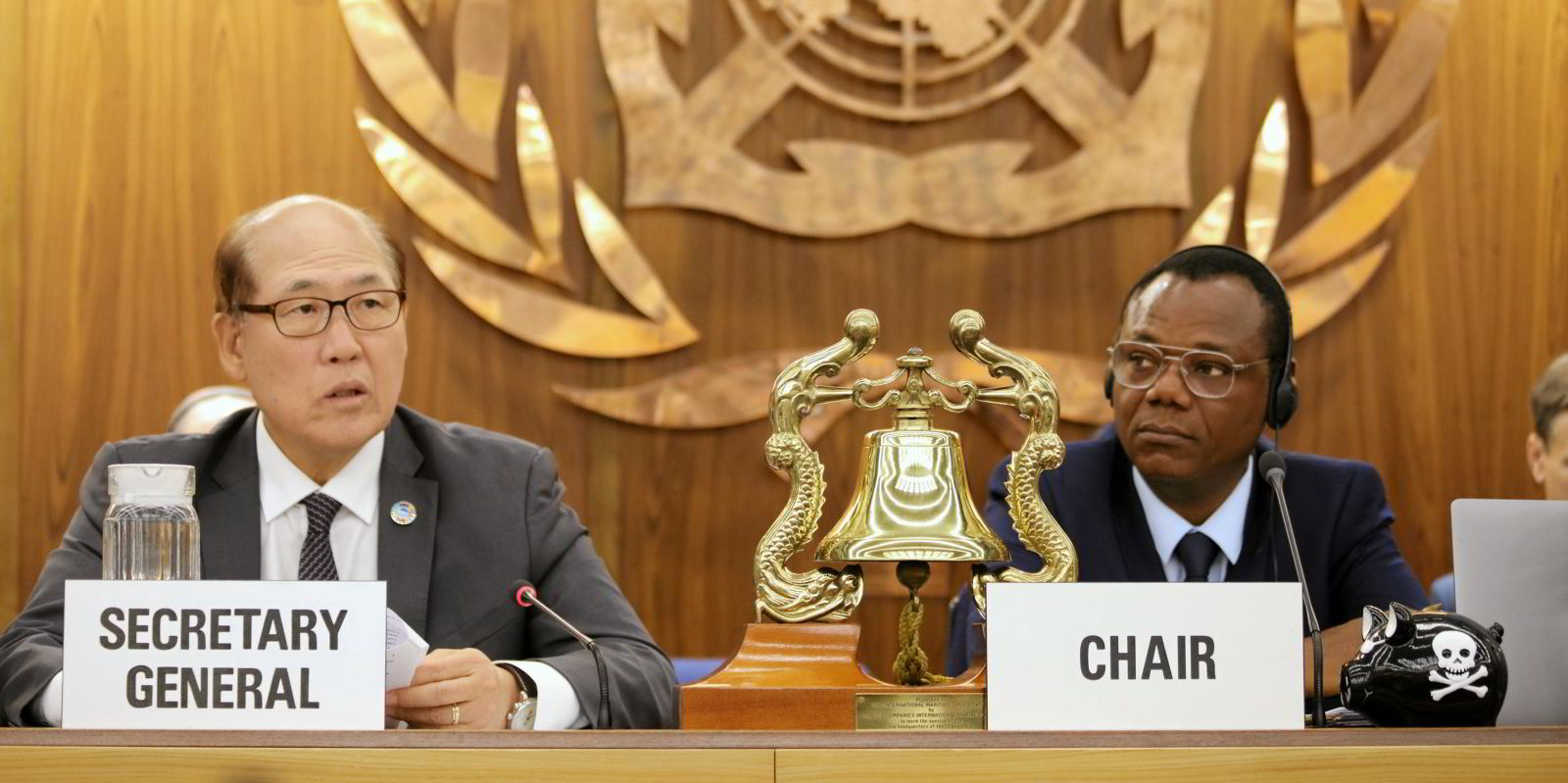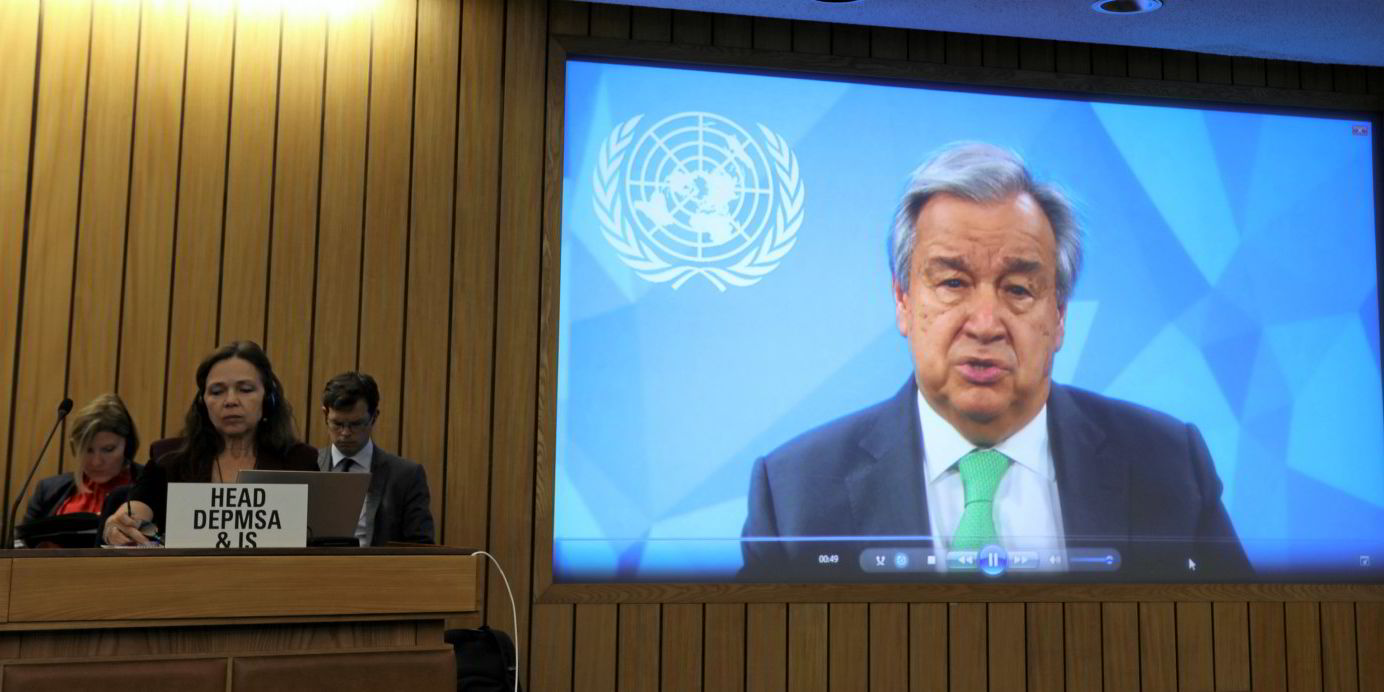While the International Maritime Organization’s historic resolution on shipping’s greenhouse emissions left some disappointed, the decision did make progress in moving the industry closer to the goals of the Paris Agreement on climate change.
That is the conclusion of UMAS consultants in a report that followed last week’s meeting of the IMO’s Marine Environment Protection Committee (MEPC), which adopted a net zero target for around 2050 in addition to aiming to cut greenhouse gas emissions by 20% to 30% at the end of this decade and by 70% to 80% by 2040.
UMAS director Tristan Smith and policy lead Alison Shaw wrote that the final agreement is not in line with capping global temperature rises at 1.5C — but that does not mean it is beyond reach.

“With a combination of further IMO action, and wider national, regional and industry action, a 1.5C-aligned greenhouse gas reduction pathway is more clearly in reach than before,” they wrote.
To learn more about how the IMO’s new greenhouse gas strategy moved the decarbonisation ball forward and what comes next, TradeWinds’ Green Seas podcast interviewed Smith, who is also an associate professor in shipping and energy at University College London’s UCL Energy Institute. The conversation has been edited for length and clarity.
Question: When the new targets were still in draft form, you said they were not in line with the Paris Agreement. What is that going to mean for shipping’s decarbonisation pathway?
Answer: It means that we don’t stop talking about 1.5C, unfortunately. It would have been really nice if the IMO had come up with something that would have buried the subject of, ‘Is this an appropriate level of ambition? Does it need to be revised? What do we think about regional action?’ But it leaves all of that on the table because it is not a proportionate share of the [carbon] budget for being aligned with 1.5C. Those numbers, as we calculate them, are 37% reduction in 2030 and 96% reduction in 2040.

What you can say is that it leaves those values within reach in practice. This is a transition that is not driven only by the IMO. It is driven by a combination of IMO regulation, regional, national and industry actions. And so it is also a strategy that will be revisited again in 2028.
Unfortunately for the industry, it means that there remains uncertainty about the timing of when those numbers might be revised upwards, and exactly how they would be changed in the future.

1.5C alignment: Whether a decarbonisation strategy follows a path to cap global temperature rises at 1.5C, which is also described as the goal of the Paris Agreement on climate change. The Science Based Targets initiative estimates that for shipping, aligning with a 1.5C pathway involves cutting emissions by 37% relative to 2008 levels in 2030 and 96% in 2040, fully phasing out greenhouse gases by 2050.
Carbon budget: The cumulative amount of greenhouse gas emissions that can be emitted over time to meet key temperature goals.
Carbon Intensity Indicator: One of the short-term measures rolled out at the start of this year, the CII grades ships based on their carbon emissions, tonnes carried and distance travelled.
Comprehensive impact assessment: Developing countries have asked for this analysis of the impact of policy measures on their economies.
Marpol: Formally the International Convention for the Prevention of Pollution from Ships, it is the IMO’s main treaty for pollution rules.
MEPC: The Marine Environment Protection Committee is the main arm of the IMO dealing with greenhouse gas emissions. Its next gathering is MEPC 81 in April 2024.
Midterm measures: This is the next phase of policy measures to be adopted by the IMO to push shipping towards its new targets. Under discussion are an economic measure, such as a carbon levy, and a technical measure, likely a fuel standard that would require greenhouse gas intensity reductions over time. A combination of the two is expected.
Question: Would you describe this as disappointing or as better than you expected from the IMO?
Answer: I describe it as disappointing from the perspective of 1.5C, which is the temperature goal that we are all dependent on for our future, and many are very significantly dependent on, depending on the countries and their circumstances. But that does not mean it is not still a massive change. I do not think it is not necessarily about the emotions associated with the numbers. It is about: What does this now mean, and how does anyone modify to make a decision and a strategy that goes with what is clearly a better signal than we had previously on the next 15 to 20 years but still retains some uncertainty and risks that will need to be managed?
Question: What do you think about the qualifiers in the wording of the resolution, such as “indicative checkpoints” and “by or around 2050”?
Answer: There is always ambiguity in these things, unfortunately. And that is where it is so difficult because anyone in the industry would like something very clear. And certainty and clarity are normally what help investment, or maximise investment. But it is a very difficult political, multilateral agreement that has to have a lot of countries with different concerns comfortable, and that is normally achieved through that ambiguity. But what it shows you, actually, is that there is, despite the ambiguity, quite a lot of common ground.
Question: In the case of IMO member states that were not in favour of that 37% emissions cut in 2030 and 96% in 2040, what concerns prevented that stronger signal?
Answer: I think there are two sets of concerns. One is the technological set and the other is transport cost/trade impacts. The technological ones relate to fuel availability, shipyard capacity and maturity of solutions. And that has been a very valid point made over the last couple of years about the extent to which we can be confident that those will mature and be available in volumes.
And I think, the first thing is that this resolution will unlock the midterm measures to be designed to stringencies that will create good investment cases by 2025, which is when the timescale is for the adoption of midterm measures. So that is the point at which you can actually see the numbers in the Marpol amendment that will be driving compliance requirements and therefore business case. So with investment flowing from 2025, we will know a lot more in 2028. When these numbers are revisited as to whether or not that investment is at a pace, that is going to be consistent with an even higher number for the 2040 target, or indeed whether there is some evidence that is challenging — whether the 2040 target is viable. So there will be more information that affects the technological parameters.
The questions around transport costs come from many of the countries that are far from their markets and worried that the generalised increase in transport cost, which many of them associated with a levy but is actually just a feature of the technology transition generally, will have competitive disadvantage consequences for them as they export their goods into the global markets.
That is something which is significantly affected by the way we design policy measures. And that is something we will revisit at MEPC 81, when there should be an interim report from the comprehensive impact assessment on states, which is the kind of key piece of analysis that shows how the policy measures for achieving those greenhouse gas reductions might then impact different countries. And that debate and how that is settled by the different member states is key for the confidence of the countries with those concerns as we go to any kind of further stringency increase or implementation of policy.

Net zero target: Emissions by international shipping should reach net-zero “by or around, ie close to 2050, taking into account different national circumstances”.
Indicative checkpoints: Reduce total greenhouse gas emissions from international shipping by 20% to 30% in 2030 and 70% to 80% in 2040, compared to the 2008 baseline.
Carbon intensity: Reduce CO2 emissions per transport work by 40% by 2030, compared to 2008.
Green fuels target: Uptake of near-zero or zero-emission fuels should reach 5% to 10% of energy use by 2030.
Adoption of measures: The MEPC is scheduled to decide on midterm measures by the end of 2025, in addition to revising short-term measures.
Question: Where do you think the discussions around a carbon levy or another kind of economic measure are headed after these two weeks of discussions?
Answer: [We will] have better data from analysis that goes on in the comprehensive impact assessment, a more in-depth analysis of the impact of different policy options — so something that shows what the consequences of a greenhouse gas fuel standard are, and how that compares with various different variants of a levy and different uses of revenue.
The key question is not so much what the carbon price is, but what do you do with the money that arises from that, to find the right balance between the in-sector uses, which obviously are attractive for supporting the transition, predominantly in our opinion in stimulating the production of new fuels, and the way those are distributed between countries, including for purposes beyond the shipping sector’s transition? That could address some of the climate impacts of shipping. It could include technological inclusivity, making sure that developing countries have a good opportunity during the transition. So there are overlaps between those things.
That is why it really needs to have some good analysis to help the countries be reassured that they are getting a fair deal in the way that the policy package is designed and that we are not locking in an advantage to certain countries or ending up with countries that either get economically damaged in a serious way or get left behind from a technological perspective. And that is incredibly difficult. The way that step has now been set up at this meeting, we have a very good chance of having a good basis for the discussion and a lot of trust between the countries that need to find the right solution there.
Question: What is the next big thing that we should be watching out for at the IMO?
Answer: I think that MEPC 81 meeting [in April 2024] is going to be really important to get a clearer sense of what the policy measure package might be. But really, the thing that will be most likely to have an impact on the sector sooner is CII [Carbon Intensity Indicator] revision, being a process that starts anytime now, and needs to be completed by the end of 2026. So we will need to operationalise the 2030 target, because that is the main tool for getting an efficiency increase beyond the trajectory that we are on at the moment, which is going to need strengthening to get us to the 20% and to strive for the 30% target that has just been agreed. I think that is the one that affects the most near-term action. The way that that solidifies affects the way strategies might be set around the use of things such as biofuels or further energy-efficiency improvements on the existing ships and strategies about newbuildings and retrofitting of those vessels. So there is a lot that will need to be judged and done very quickly, which means doing something even before that.

Question: Given what has happened in these two weeks of meetings, how important is the IMO to shipping’s decarbonisation pathway when weighed against regional, national or private sector action?
Answer: We have written stuff that describes this as being a multi-lever transition. We have never tried to say this is all about the IMO. Obviously, it would be cleanest if it were driven wholly by the IMO, because that would be the most unambiguous transition. But we have to acknowledge the realities of a multilateral process, and the role that regulators in different regions and ... national strategies have been playing here, as they have in any part of the transition. This is not something that is uniquely about shipping.
I do not know how I would put any sort of proportion on it, because the IMO provides a certainty about a mass-market transition. The phase we are in at the moment is actually about the emergence of new technologies and adoption of those new technologies in small volumes, to gain experience, to get crew-training issues resolved, to figure out safety, to figure out how you develop supply chains and to make investment cases, and that is not something that the IMO necessarily does for other technology transitions. It was not the case for the sulphur transition, which was driven first through regional measures. It was not the case for NOx emission control.
So I would not have ever said that it was solely the IMO’s responsibility for that. It is something that we could easily share, and I think we do need to share across all of those different forums. And as long as the IMO is able to bring the mass-market transition that we really need in the 2030s, to act at high velocity, which the regulations that come out of this resolution will need to be designed to drive, then we still have a very significant role for the IMO. But it is going to be a test that the IMO is constantly held to. It is not by any means resolved one way or the other, just because we have adopted a resolution with stronger numbers.
Read more
- Editor’s Selection: IMO misses open goal, counter-cyclical Greeks buy into dry bulk and Iran snares tanker
- Scandinavian shipping groups cheer IMO’s net zero ‘at or around’ 2050 agreement
- Shipowners will do ‘everything possible’ to achieve new IMO goals
- IMO lines up carbon pricing mechanism commitment by 2025
- IMO forges ‘wish and a prayer’ carbon deal as greens bemoan checkpoint targets
- MAN Energy Solutions reveals ammonia engine breakthrough in ‘911 call’ to IMO




